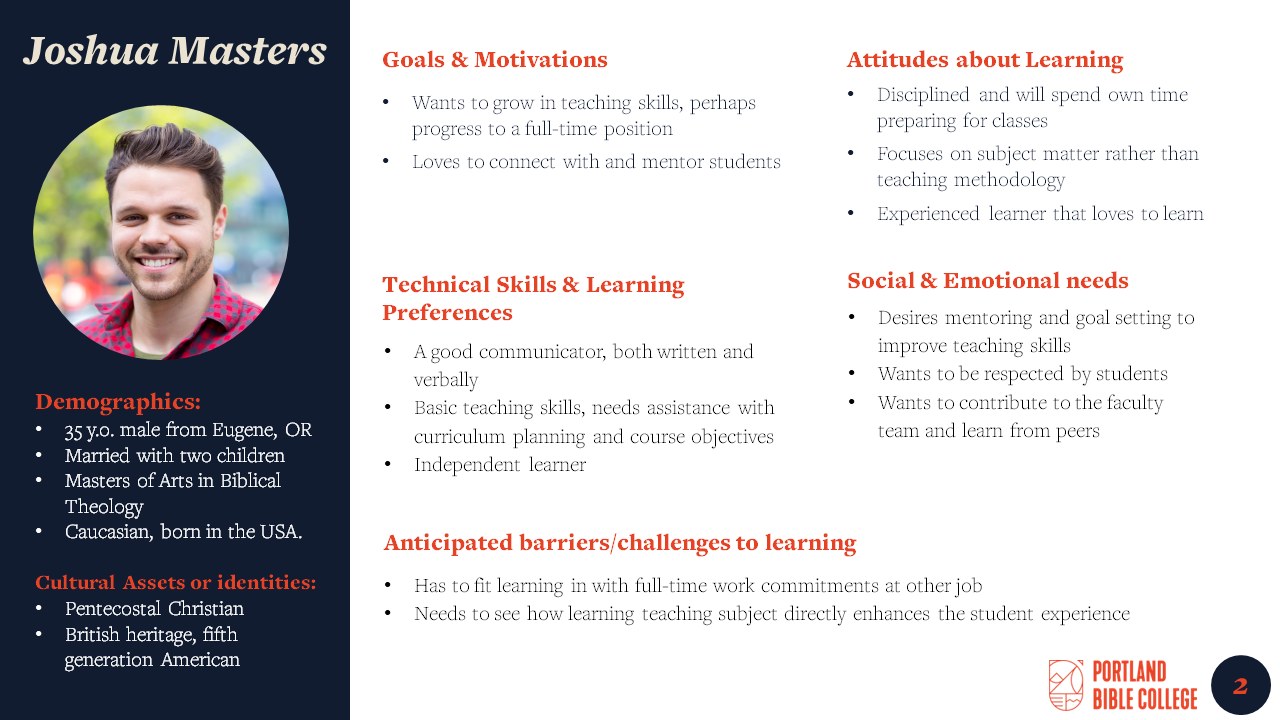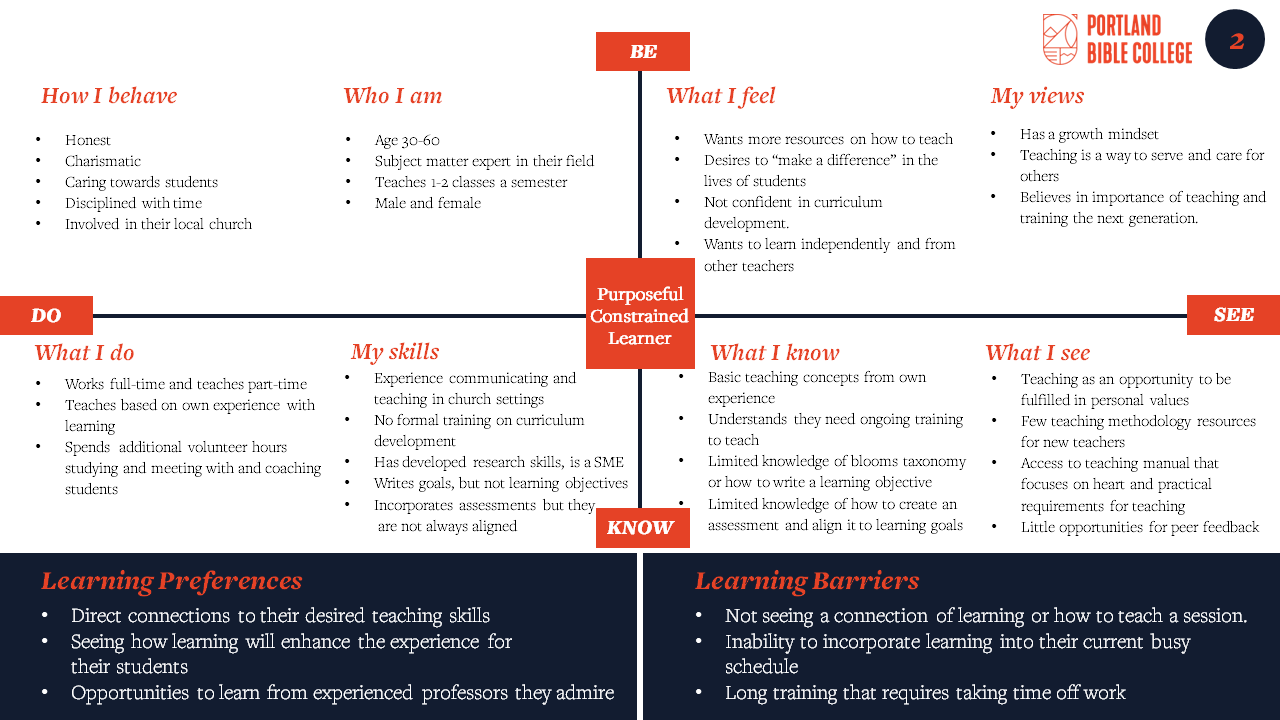Instructional Alignment
Overview
Product Type: On-demand E-Learning course
Client: Portland Bible College
Context: Adjunct faculty at Portland Bible College, like many Higher Education institutions’ are subject matter experts, but receive no formal training in teaching methodology or curriculum development. As a result, their courses reflected lower scores in curriculum organization and course satisfaction. As adjunct faculty were motivated learners who wished to improve these skill gaps, the stakeholders at Portland Bible College wanted to develop a range of courses on teaching methodology for Adjunct Faculty and Teacher Assistants that they could access on-demand. I was tasked with conducting a learner and task analysis, along with researching and incorporating current E-Learning best practices to design, develop, implement and evaluate a solution.
Deliverables: Articulate Rise E-Learning course including:
Three week email and slack campaign encouraging eligible staff to sign up for the course.
PDF job aid on the steps of instructional alignment.
Assessment with grading rubric and word .doc template.
Nine instructional guided walk-through videos (three examples on each of the three steps).
Three sets of practice exercises with customized feedback.
Evaluation: 90% of learners rated the course 5/5 for usefulness and worthwhile training. There was a mean 2/5 point increase in both learner confidence and skill in Instructional Alignment skills. 80% of eligible faculty and teacher assistants voluntarily signed up for the course and 75% completed it within 1 month.
Responsibilities: Instructional design, research, graphic design, script writing and video production, evaluation and reporting.
Tools used: Adobe Photoshop, Illustrator and After Effects, Articulate Rise and Storyline360, Google Suite, Microsoft Suite, Populi LMS, Amazon Web Services.
MY PROCESS:
I used Design Thinking to create this course:
EMPATHY:
In-formal interviews were conducted with Faculty and stakeholders to identify the key topics that the learner population would find worthwhile, along with their core needs and desires for professional development. As the course offerings would be optional, it was essential that the learner preferences were central to the topics chosen. I used data from the interviews and needs assessments to create empathy maps and personas. These were reviewed by stakeholders and adjustments were made based on their feedback.
Example empathy maps and personas:
DEFINE
Instructional Alignment was the topic chosen by stakeholders and so I conducted a KSA (knowledge, skills and abilities) analysis, created a problem statement with associated learning objectives and conducted a literature review on instructional alignment and e-Learning professional development for Higher-Ed Faculty from current journals, textbooks and professional sites.
Learner analysis of these groups found that core needs were competency and confidence in their teaching along with community and connectedness to the institution. There currently was no formal training on instructional alignment (which the literature review supported as a common problem amongst Higher-Ed institutions) and this group of learners creates sessions from their own study and experiences.
Problem Statement: Adjunct Faculty and Teaching Assistants need to learn how to create robust instructional alignment between learning objectives, learning activities and assessments to feel competent and effective in their teaching.”
Learning Objectives: (an example from step one, write learning objectives)
After completing this section, the learner will write one learning objective, using a Bloom’s taxonomy verb and the ABC criteria, for a course topic of their choice, using the template provided.
This terminal learning objective is achieved by the following enabling objectives:
The learner will explain what a learning objective is.
The learner will list and describe the ABC criteria for writing learning objectives.
The learner will list the six cognitive levels of Bloom’s taxonomy and describe how they are used as a tool for writing learning objectives.
IDEATION:
The Literature review and interviews provided rich data with which to begin the ideation process. A summary of the literature review and three possible learning solutions were presented to stakeholders. These included: (1) Self-directed website resources, (2) LMS collaborative, synchronous course and (3) LMS scenario-based individual asynchronous course. There was a tension between wanting to offer opportunities for interaction between Faculty members (solution 2) and providing flexibility for Faculty to access the course in their own time (solution 1 and 3). Ultimately, solution 3 was chosen by stakeholders as it provided the most flexibility and was trackable through the institution’s LMS. Stakeholders decided to address the need for community and interaction through a separate solution.
I used the Understanding by Design methodology to map out course content and incorporated principles from cognitivism, competency-based assessment and problem-based learning to guide design decisions. As instructional alignment is a tangible skill, I used a real-world assessment and incorporated the steps of this assessment into each section so the learner completes each step as they progress through the course material. Content was carefully scaffolded using Bloom’s taxonomy principles to ensure the learner was well equipped to complete the assessment.
PROTOTYPE
A word document was used to create a course overview chart (flow of content, assessments and interactive elements) and a text storyboard was used for section content. This phase went through multiple iterations with the stakeholders before the course was built in the institutions LMS, populi. A high fidelity mock-up was used for initial testing. The design and development timeline for the first iteration was limited, so detailed graphic design elements were postponed for iteration two. Quality and accessibility checklists were used to ensure the final product met current guidelines.
IMPLEMENTATION AND EVALUATION
The first iteration was built in the institutions LMS. There was a three week sign-up window and the course was available during the semester break for 4 weeks for learners to complete at their own pace. Evaluation included a 10 question internet survey and the results were presented and discussed with stakeholders. An evaluation report included graphed results of each of the questions and a prioritized list of improvements based on this feedback for iteration two.
ITERATION 2
The second iteration was rebuilt using Articulate rise so that the institution could offer it in an alternative LMS (there were changes in pricing that necessitated this move). Four out of the five proposed changes were incorporated including: adjusting assessment instructions, increasing video volume and reducing readings. Additional time was available for graphic design, so customized graphics and two additional interactions were added. An updated storyboard, branding assets and prototype were created before development of the final product.









